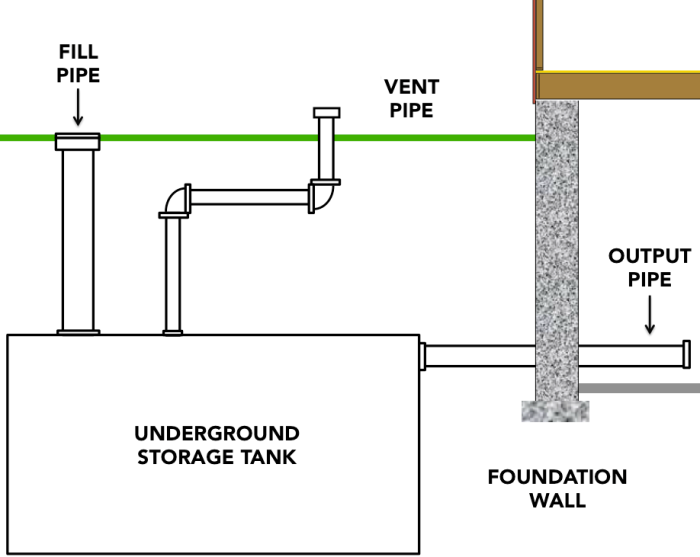
Even if your heating oil tank is unregulated, a leak could be very unfortunate, not only for the environment, but for your pocketbook, too. When an underground tank or pipe leaks, the cleanup can cost tens of thousands of dollars and, if your homeowner's insurance policy contains a "pollution exclusion" clause--which many do--you could get stuck with the bill.
One way to address these concerns is to remove your underground tank and replace it with a new underground tank or a new aboveground tank installed in your basement, garage or storage shed.
Underground tank replacement considerations
Like all equipment, tanks have a limited useful life and eventually have to be repaired or replaced. Many underground home heating oil tanks are similar to the 275-gallon steel tanks you have probably seen in basements or garages. These tanks were not designed to be buried and, if left in place, will eventually corrode and leak. Even larger tanks that were specifically designed for underground use will leak if they are not protected from corrosion.
If you notice an unexplainable increase in your home heating oil use, your tank may be leaking. But that information alone is not always an accurate indicator. In some cases, water may leak into the tank or the leak may occur only when the tank is full, thus hiding the problem from the homeowner.
While possible, the odds are that an underground tank 10 or 15 years old probably is not leaking. However, the likelihood of a leak increases as the tank gets older. Even small, slow leaks can pose a serious threat to your family, your neighbors and the environment if they go undiscovered for a long time. And if your tank does leak, you may face a costly cleanup. Having an old tank replaced with a new, modern double-walled underground tank or new aboveground tank can save you both money and anguish in the long run. Don't forget to replace piping when a new tank is installed. Contract with a reputable equipment dealer to be sure the tank is installed with overfill alarms, vents and other vital equipment.
Removal costs for an underground tank
Removal can cost from $1000 to $5,000 or more, depending on the size of the tank, its condition, and how easily it can be reached. To help ensure that you avoid this cost, have the tank condition evaluated by a qualified contractor. If it is to be removed, the vent and fill pipes must also be removed or the fill pipe must be capped with concrete.
Have a tank tested for leaks
Many underground home heating oil tanks are similar to the 275-gallon steel tanks you have probably seen in basements or garages. These tanks were not designed to be buried and, if left in place, will eventually corrode and leak. Even larger tanks that were specifically designed for underground use will leak if they are not protected from corrosion. If the tank is cracked or rusted through and leaking, it will probably need to be replaced, and contaminated soil will need to be removed and properly disposed of, each of which may be expensive
Option: emptying oil from a tank and leaving it underground
Depending on jurisdictional regulations, emptying the tank and leaving it underground may be an options... if certain measures are taken.
Regulations may require that aboveground the tank be emptied, cleaned and purged of all vapors. It must be filled with an inert material such as sand, and the vent lines must remain open and intact and the fill line capped or removed.
Removing the tank will make it easier to check for soil contamination. If you decide to sell the home, a bank or the buyer likely will ask for an environmental assessment or the removal of the tank or any contaminated soil. Having the tank and soil inspected when you purchase will allow you to negotiate with the seller for any removal and cleanup costs.
Tank leakage Concerns
Contamination may be indicated by soil that is stained or gives off strong oil odors, a sheen on groundwater, or environmental test results. If the tank is located near any wells, drinking water supplies, wetlands, ponds or streams, or if there are any indications that contamination is present, sampling and analysis is highly recommended .
When shopping for a contractor, ask if their service includes an environmental assessment.
